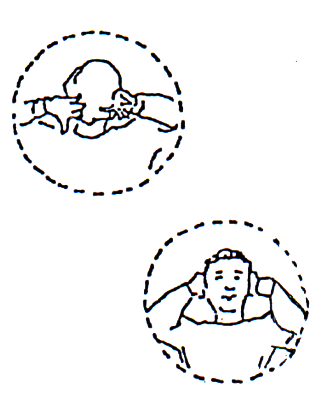(打通眼、耳、口、鼻及後腦神經)
這是對耳朵和後腦的運動,方法是很簡單而易學的。
預備式:用雙手抱後腦,抱腦的方法是用右掌心壓著右耳朵,左掌心壓著左耳朵,兩掌的掌心壓向左右的耳孔,於是右手的五隻手指便抱緊右側的後腦,左掌的五隻手指也抱著左後腦。這時必須注意,抱著右後腦的右手中指,和抱著左後腦的左手中指相對。
開始:將雙掌用力掩壓著耳朵,然後先用右手的食指放在右手的中指上面,用力壓下去,在右手食指自右手中指的邊緣滑下,向右後腦處彈下去,彈一下再將食指放在中指上,再彈第二次,彈時數著「一、二、三、⋯⋯」至十為止,這是彈右後腦的動作。然後,輪到左手的食指放在左中指上,利用壓力滑彈左後腦,方法如同右手一樣,也是彈十下為止。在右食指彈右後腦時,左掌和右掌都同時壓著耳朵,不可放鬆。彈左後腦時也一樣。
中國古代健身法中有「鳴天鼓」一式,與何琼師傅所創的這一式有近似之處。但「鳴天鼓」是左右食指一起彈動的,而彈動的次數是七七四十九之數,這是因為古代健身法沒有用手指打壓太陽穴和百會穴等運動,對腦部沒有全部按摩,便要做七七四十九次之多。
這一式「掩耳彈指」,對眼耳口鼻和後腦的神經腺都起按壓作用,可防止耳鳴、眼流和鼻敏感。大家都知道眼耳鼻喉是互相關連的,懂得深海潛水的人,在潛水升起時都懂得用手 實鼻頭,用力呼氣作為減壓的一種步驟,就是因為耳眼口鼻互相關連,可使空氣對人體的壓力減低的動作。「掩耳彈指」使耳朵受到壓力,再用食指彈後腦,於是眼中的水分不流入耳孔,可防中耳炎及流耳膿,口腔的津液不向上行而咽於喉內,咽下肚去而解渴,故做「六通拳」健身操,雖然滿身大汗,仍不必飲水,就是這個緣故。

Posture 30: Cover the Ears with Hands and Press the Fingers
The thirtieth posture of Luk Tung Kuen is known as “Cover the ears with hands and press the fingers”. This exercise is good to the ear and the brain. It is easy to learn.
Starting position: Put the hands on the back of the head and cover the ears with the palms. Thus the fingers are touching the back of the head. Remember that the middle finger of the left hand should point to the middle finger of the right hand.
Movement 1: Place the index finger of the right hand on the middle finger, then slap the index finger down to tap the back of the head. After tapping once, place the index finger again on the middle finger and tap again. Do the movement for ten times.
Then it is the turn for the left hand. Do the same movement as has been done by the right hand and do the movement for ten times. Remember to cover the ears with the palms. Other traditional Chinese exercise has a posture known as “Wu Tian Gu” (鳴天鼓) and the movement is similar to this posture. But the posture “Wu Tian Gu” is to use the right hand and the left hand to tap the back of the head at the same time and one needs to do the movement for forty-nine times.
This posture is good to the eyes, the nose, the ears, the mouth and the nervous system of the brain. It can prevent tinnitus, watery eyes, allergic rhinitis. This posture forces the ears to receive some pressure, thus when we tap the back of the brain, the tears will not fall into the ears, thus prevents otitis media.
